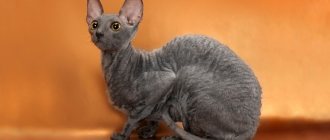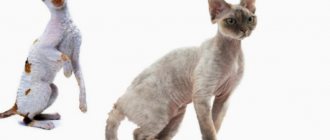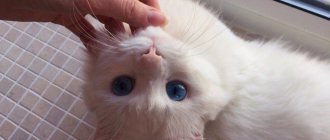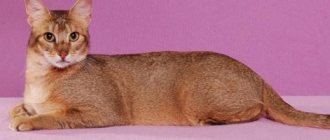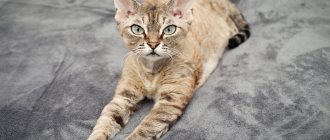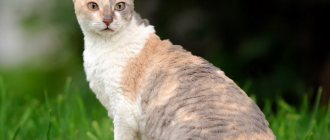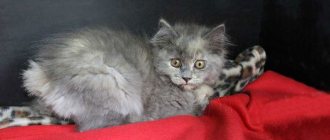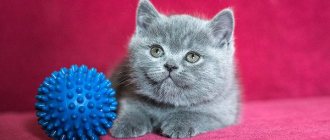Pets of the feline species have been tamed for a long time and live in apartments and houses of people. Breeders are constantly working to create new breeds, but there are species that are undeservedly unpopular. The Cornish Rex belongs to this group, and breeders believe that this is unfair, since it is difficult not to fall in love with them.
Key facts
The name of the breed comes from the county of Cornwall, located in the southwest of England, and the curly-haired rabbit of the rare Astrex breed. The country of origin of the Cornish Rex is recognized as Great Britain, where the first selection work to develop a new breed began.
Description of the Root Rex breed includes size standards. The weight of the Cornish is from 3 to 5 kg and depends on gender. Maximum sizes are typical for males. The average life expectancy of the Cornish Rex is from 14 to 16 years and is explained by a strong immune system and the absence of specific diseases transmitted at the genetic level.
The breed is distinguished by its curly coat, which is obtained by inheriting the recessive “rex” gene. The wavy curls covering the entire body of the animal resemble velvet. The aristocracy of graceful proportions is combined with developed body muscles; harmony is a key characteristic of the Cornish Rex in terms of appearance.
Cornish Rex are excellent jumpers, able to climb any elevated surface. These monkey habits often end in tragedy for vases or other fragile dishes, so experienced owners are advised to think through the entire storage system in advance.
Among the disadvantages of the breed, breeders note increased talkativeness. Undoubtedly, most cat lovers will count it as a plus, but sometimes the cat becomes too annoying. Keeping with other animals does not always help to redirect the pet’s increased attention, since the Cornish’s main interest is the owner.
If you are ready to devote most of your time to a cat, and the possibility of close contact with the animal is your main priority, then don’t even think about it. The curly-haired pet will quickly settle down on your lap and will gladly support any dialogue with funny and varied sounds.
Just a hypnotist cat
Still very small...
“I sit high, I look far away!”
Ready to attack!
These are the ears!
What do you think of this color?
Why are you upset, little one?
Grace in every movement
History of the origin of the Cornish Rex
The country of origin of the breed is recognized as Great Britain, but the Germans claim that the first representative with curly fur was spotted on their territory. Shortly after the end of World War II, an unusual kitten settled next to a Berlin hospital. At that time, the residents were busy rebuilding the country and missed the chance to breed a new species.
The founder of the breed was the Englishwoman Nina Ennismore from Cornwall. In the 1950s, her beloved cat Serena gave birth to a ginger and white kitten with huge ears, curly hair, a lithe body and a wedge-shaped head. The baby with an extraterrestrial appearance stood out from the rest of the litter. All the other kittens had the classic appearance of English cats: strong bones, round heads and dense fur.
The further history of the breed was accompanied by many interesting facts that constantly threatened to put an end to curly-haired Cornish Rex cats. Miss Ennismore's charming ward, named Kalibunker, almost lost his ability to reproduce. The owner hurried to take him to be castrated, but was stopped by the veterinarian, who noted the animal’s amazing potential.
The little kitten was taken to Stirling-Webb and Jude, experienced breeders in the field of felinology. Scientists confirmed the uniqueness of Kalibunker and insisted on breeding him.
The first experiments were a fiasco. All kittens born from the mating of Kalibunker and his partner were born with straight hair. The results were crowned with success only when they decided to cross the curly cat with his mother. Three kittens from the litter inherited their father's appearance, which confirmed the recessiveness of the gene responsible for curly hair. Of the new curly-haired offspring, only one boy, named Poldu, survived.
Sudden financial difficulties befalling Miss Ennismore led to the forced euthanization of Serena and Kalibunker. The only survivor was a Cornish Rex cat named Poldu, bought by Stirling-Webb. Unfortunately, during the sampling of the material, the cat was accidentally castrated, but before that he managed to leave behind offspring. In 1967, the breed received official registration.
Ten years earlier, in 1957, the breeding of the American Cornish line began. A cat named Lamorna Cove was brought to the United States, bearing kittens from the victim Poldu. At first, Americans used Burmese, Siamese and American Shorthair cats to breed the breed. Such experiments resulted in deviations from the British standard, but allowed the development of many new colors.
After the breed was recognized by the largest felinological organizations in 1983, outbreeding, which involves breeding by crossing different breeds, was banned.
What breeds are there?
As already mentioned, there are several varieties of Rex: German, Dutch, Bohemian, Devon Rex and Cornish Rex. Let's take a closer look at each type.
German
The German Rex is a playful and affectionate animal, differing from its counterparts in its fur. His hair is wavy and velvety. The coat color and pattern of a German can be absolutely any. Such a cat has an elegant body, medium size and a round head. The ears are small and neat, the eyes are almond-shaped, and the cheeks are prominent. The German Rex breed appeared in Germany randomly in the 1950s and 60s, and it is still not known for certain where the breed of curly-haired cats came from in this country.
Dutch
The Dutch Rex breed differs from others in its short and hard, curly hair. According to the description, this cat has a small head, large ears, long legs and a graceful body. The coat curls over the body in small, stiff curls or short waves. As with the German Rex, the color and pattern of the coat can be any.
Bohemian
The Bohemian Rex is a very interesting and aristocratic variety of Rex. Its main difference is its long and thick wavy coat. The breed appeared in Czechoslovakia in the 80s of the last century, when a pair of Persian cats gave birth to kittens with curly long hair. Bohemians have fluffy soft fur, neat ears and paws, a wide and short neck, rounded cheeks and a clear, strong chin. Looking at such a cat, there is no doubt that this is a special breed.
Devon Rex
Devon Rex cats are native to Great Britain. They are loving, lively and extremely friendly.
Devon Rexes have an interesting appearance - in addition to short soft curly hair, they attract attention with a round head, large ears, thin neck, long body and legs. This cat is elegant and graceful, at the same time very playful and loves to run and jump, unlike, for example, the Scottish breed
Devon Rex coat colors can be any color, the most common being solid black, white, grey, tortoiseshell point, bicolor and cinnamon.
Cornish Rex
This is an amazing and beautiful breed of cat. Their fur looks like a soft astrakhan fur coat with neat, clear curls. This breed is divided into American and European, the differences between them are only in the curve of the back and the shape of the head. The European Cornish has a straight back and a round head with relatively small ears. The American breed has an arched back and a small, pointed head.
Cornish kittens are friendly and loving. They get along easily with children and love outdoor games and walks. And they cannot stand loneliness at all, so Rexes are not suitable for those people who are often not at home.
What does a Cornish Rex look like?
The general impression that emerges after meeting purebred animals is twofold. Fragility and sophistication are combined with strong bones, strong muscles and sharp claws.
The difference between American and English Cornish can be seen in the photo. Cats from the USA are more sophisticated than those from the UK. According to the approved standard, the maximum size of animals should not exceed 5 kg. This indicator is typical for cats. The weight of cats varies from 3 to 4 kg.
Breed defects include:
- massiveness and stockiness;
- sparse hair or the presence of bald patches;
- small ears;
- short tail without hair or with increased shaggyness;
- wide or long head.
Such animals are discarded from breeding. Sometimes even in a photo of a Cornish Rex you can notice a defect.
Muzzle
The head of the “Americans” resembles an egg, and the head of the “English” has the shape of a triangle. In both cases, the length of the head should exceed the width by 2 times. The wedge-shaped muzzle has clearly defined cheekbones. The Roman type of nose with a characteristic tubercle is located in line with the chin. The ears are set high and tapered at the tips. The color of the huge almond-shaped eyes depends on the color. The teeth are characterized by a scissor or level bite. A light snack is considered acceptable.
Body type
The head is located on an elegant and moderately long neck with well-developed muscles. The slender torso is slightly elongated and is accompanied by a toned stomach, moderately wide chest, defined waist and arched back.
The hind and forelimbs have thin bones but strong muscles. Strong pushes made by the hind limbs allow him to climb to the highest places in the house. Neat paws with long and well-developed toes are collected in oval pads.
The long and thin tail, tapering at the tip, is flexible and mobile.
Coat and color
You won’t be able to judge the softness of wool in pictures, so you need to get acquainted with soft plush only tactilely. The peculiarity of the breed is the complete absence of guard hair. The entire coat is a soft undercoat that lies tightly to the body. The minimum length of fur and the greatest number of curls are characteristic of the chest, lower part of the chin and belly.
A purebred kitten is visible from birth, but as it grows, it may lose its curls. It can be distinguished from a mestizo only after a year, when the curls return to their proper place. In addition to fur, Cornish cats have curly eyebrows and mustaches.
Acceptable colors of the Cornish Rex include:
- black;
- cream;
- ginger;
- white;
- blue;
- chocolate and many others.
Now they are stricter about color than 20-30 years ago. The American and English varieties of Cornish Rex have similar colors, and only a specialist can visually distinguish them.
Description of the breed
Standard
- Body: small, elongated, with developed muscles. The back is arched, forming an arch. The weight of a cat reaches 3.5 kg, a cat - 4 kg.
- Limbs: long and thin, paws small, oval in shape. The tail is also long and thin and flexible.
- Head: wedge-shaped, with pronounced contours and rounded cheekbones. The forehead is flat, the nose is hooked, the profile is slightly elongated, and the cheeks are full.
- Coat: short, soft and curly, with small curls, which is a characteristic of the Cornish. There is no guard cover. Color varies, with the most common being white, black, gray and red seals.
- Eyes: almond-shaped, elongated towards the edges. The color matches the coat. Color point cats only have blue eyes.
- Ears: large, set high, tapering and pointed towards the tips.
Health
The health of these cats cannot be called strong. These cats are susceptible to a number of complex diseases.
- Hypoglycemia. It is a developmental pathology, expressed in a lack of glucose in the blood.
- Progressive retinal atrophy. It is also a pathology. This term hides several symptoms that inevitably lead to the kitten’s blindness.
- Hypotrichosis. A congenital disease characterized by uncontrolled hair loss.
- Solar dermatosis. It can develop as a result of hypotrichosis and subsequently lead to more serious consequences, for example, skin cancer.
The first two diseases develop if both parents are carriers of a recessive gene. Sick kittens should be examined by a veterinarian. Animals with pathologies are not allowed to breed.
To prevent the development of solar dermatosis, the cat should not be exposed to the open sun.
In good conditions, the Cornish Rex will live about 15 years. Some cats can live up to 20.
Character of the Cornish Rex
Cornish Rexes are kind and affectionate cats. Breeders note that these cats do not know how to be alone. They need a lot of attention from their owner, since Cornish Rex cats are attached not to the house, but to the person. Left at home alone, they feel sad and try to find something to do that is not always approved by their household.
Cats of this breed are easy to train and follow some simple commands. They will happily bring a thrown ball to their owner or lie down at their feet.
Such cats are playful and inquisitive, and they retain these qualities throughout their lives. The Cornish Rex can even invent games on his own. In addition, they get along well with children and other pets.
Thus, the main character traits of the Cornish Rex are:
- Playfulness.
- Devotion.
- Curiosity.
- Friendliness.
- Attachment.
- Learning ability.
Possible problems
- The Cornish Rex's short fur will not save it from either frost or scorching sun.
- The cat’s health must be protected, because due to their structure they are very sensitive to anesthetics. During surgery, the Cornish Rex may simply not survive anesthesia.
- If you are a busy person, then the Cornish Rex is not for you. When you arrive home, you will see torn pillows and broken cups - victims of cat games, and next to it - the cat himself, offendedly staring at the floor.
- The Cornish Rex's paw pads are small, so they cannot remove their entire claws. Your cat will need a scratching post or regular nail trimming.
Character of the Cornish Rex
Cornish is an inexhaustible source of energy, preferring racing for a ball to relaxing on a soft sofa. Cats use any discovered objects as toys, so it is better to hide valuables in an inaccessible place. Make sure you have enough interactive toys to direct your pet's activity in the right direction.
Before buying a Cornish at home, you will have to install an “anti-cat” - a special net that protects against falling from the window. Curly-haired cats love to explore the territory, so not a single flying pigeon escapes them. This sense of adventure can be dangerous without reliable window insurance.
The character of the Cornish Rex is very loyal, so the animals diligently surround their owners with their attention. Tactile signs of attention are always accompanied by sound signals that have a wide range. If you get a Cornish dog, you will soon learn to understand the meaning of the sounds it makes.
Cats treat strangers with caution, allowing close contact only after careful examination from the outside. Animals get along well with children, but do not tolerate excessive importunity. The child will not suffer from their paws, but the Cornish may receive psychological trauma from careless handling. When communicating with other animals, cats can show jealousy, and perceive rodents and birds only as prey.
Tailed pets love to sit on their hands, as they are constantly cold. Due to the small amount of fur, their body temperature appears to be higher than that of other cats, but this is a false impression. If you prefer to walk animals, then keep in mind that it is dangerous for Cornish cats to be outside in winter.
The breed is not suitable for workaholics, and even an ordinary five-day period causes an acute feeling of loneliness in cats. Cornish cats quickly become attached to their owners and are especially affectionate towards the female half of the family. The most affectionate characters are those cats that love to perch not only on the arms, but also on the shoulders of the owner.
Nutrition
Cats of this breed are not picky eaters. Like any animal, they require a normal balanced diet to function normally. The presence of vitamins and minerals is the key to the normal development of muscles, skeleton and a healthy appearance of the cat’s skin.
Active and energetic games require a lot of effort. Cornish Rex are always hungry. They can eat up to five times a day. But, it is worth accustoming them to eating at the same time in the morning and in the evening, otherwise very soon they will gain excess weight.
Of course, the owner will decide what the Cornish Rex will feed on. Selecting a diet from natural products or dry balanced food is a controversial issue. Nutritionists consider a mixed diet not advisable, since different amounts of enzymes are needed during the digestion of different foods. Although veterinarians and breeders consider mixed feeding to be the most optimal.
To select a menu made from natural products, it is worth including:
- Chicken meat;
- White fish;
- Vegetables;
- Cereal porridge;
- Cottage cheese, unsalted cheese, kefir;
- Boiled eggs, liver.
Important: If a male lives in the house, you should give up fish and seafood in your diet. Their consumption can lead to the formation of sand and kidney stones. Accordingly, problems with the kidneys and urinary tract.
If you take good care of your cat and choose the right diet, the Cornish Rex can live up to twenty years. On average, the lifespan of wavy cats is 14-15 years.
Raising a Cornish Rex
The high intelligence of animals contributes to successful training from childhood. From the first days a kitten appears in the house, adhere to one rule: do not allow things to be done that are prohibited. If your pet is marking its territory, chewing foam, or scratching the sofa, gently plop a newspaper next to it. This can only be done immediately after the crime, so that the child understands the reason for the owner’s dissatisfaction. Please note that the animal must not be beaten. The owner's hands should be associated only with affection and used as praise.
Raising a Cornish Rex is similar to interacting with dogs. He easily remembers basic commands, quickly toilet trains and enjoys walking in a harness. Most quickly, animals get used to closed trays, which exclude direct contact with the owner or other animals. In such a toilet, the cat feels completely safe and does not try to relieve itself in the wrong place.
Well-mannered pets never take revenge on their owners and carefully observe the basic rules of hygiene in the house. To be on the safe side, place scratching posts in each room in the first stages. This will help you determine your favorite type of scratching post and teach the correct behavior.
Pet card
| Characteristics of a cat | Notes | |
| General information | A breed of small curly cats | May be confused with Devon Rex |
| Character | Friendly and loyal. Enjoys spending time with family | They become attached to one owner. If you are often away from home, then it is better to keep Cornish dogs in pairs. |
| Appearance | Compact cat with long thin legs and tail. Curly soft fur | Wide variety of colors |
| Behavior at home | Loves to play and run. Not afraid of strangers in the house. especially likes to chase toys | Trainable |
| Care | Brush once every 1-2 weeks with a soft brush, bathe once a week. Clean ears and trim nails regularly | Sheds little |
| Health problems | They are susceptible to a number of serious genetic diseases. Cats are prone to obesity, so you need to monitor your cat's diet, especially after sterilization. |
We suggest you read: What can cause fester in a cat’s eyes?
Since curly-haired cats are a very intelligent breed, raising them will not be difficult. Even a child can do it. It is better, of course, to start training at a young age; the cat should know where the toilet, food and drink are, where the cat can sleep and relax. It is better to lay the bed away from noisy places in the house so as not to injure the little kitten.
The Cornish Rex cat is very clean, so the apartment must be in perfect condition so that the pet can enjoy spending time in its own territory. It follows that curly-haired cats are a breed that learns faster than others to relieve their needs where they should.
Cat food must contain all minerals and vitamins, because spending time in vigorous games, the animal loses a lot of energy.
Although their body temperature is slightly higher than that of other cat breeds, Cornish Rexes get cold in the cool season, so clothes stored in time will come in handy. Even in warm weather, rexes freeze in an apartment and climb into their owner’s arms, which is absolutely normal. They warm themselves, and in turn give positive energy to the owner.
The cat's wavy fur requires care, although it should be bathed rarely. But trimming and combing carefully is a must.
If the breed attracted you at first sight, and the decision to get a Cornish Rex dominates your consciousness, you should take into account some subtleties. When buying a kitten, you should examine its external characteristics, observe its behavior, if there are no deviations from the standard, you can take it. At home she needs to create conditions away from drafts, where it is warm and cozy.
When purchasing, you should take into account that not all external characteristics of a kitten appear already at 5 months of its life! Since there are different hairless cats, the name of the breed you are interested in should be clarified in advance.
Cornish Rex Health
The Cornish Rex is in excellent health and has a long life expectancy. With proper care, some representatives live up to 16 years of age.
Possible diseases
If infectious diseases bypass the Cornish, then several pathologies are found in most purebred pets. These include:
- Retinal atrophy. The progressive depletion of photoreceptor cells responsible for vision leads to blindness.
- Hypokalemia. A lack of potassium in the body is fraught with pain in muscles and joints, respiratory failure and dynamic intestinal obstruction. Treatment depends on the severity of the disease, but most often the animal is prescribed vitamins with potassium for oral administration.
- Metabolic disorder. The most common consequence is obesity associated with the increased gluttony of the Cornish Rex.
- Hyperplasia of the gland in the tail area, or “greasy tail”. Excessive sebum production leads to an untidy appearance of the coat and provokes the activity of fungi and bacteria.
- Alopecia. It is very easy to distinguish alopecia from seasonal shedding. Completely bald patches appear on the paws, face, ears or other parts of the body.
For your pet’s health, follow the vaccination schedule and do not forget about anthelmintic treatment.
Reproductive health
Despite the fact that the first estrus occurs at 9 months, the birth of offspring should be postponed until 1-1.5 years. Early birth is fraught with miscarriages, fetal pathologies and even the death of the pet itself. Those who are far from breeding the breed are advised to take their pet for castration or sterilization. Operations are performed at 7-8 months.
Kittens from the same litter, growing together, mature faster, so lowering the age limit is acceptable for them.
Cornish Rex pregnancy lasts 62-66 days. Kittens are already covered with curls at birth, but lose them in the first week of life. After the juvenile molt, the usual appearance of the coat gradually returns.
Breeding
Those who want to start breeding this breed should find a partner in advance. This may take several months, depending on where you live. In big cities this is easier and faster. This breed is still considered rare and has some peculiarities in its reproduction. Females become sexually mature at 9 months, but there is no need to rush. The animal’s body must become stronger and its hormonal levels must return to normal. The first mating is best done after a year. This applies to females and males. A categorically important condition for breeding a breed is a complete ban on the use of other cat breeds for these purposes. There is a risk of losing the gene that is responsible for the main characteristics of the breed - a special curly coat, ear shape and body build.
Mating and pregnancy of cats
Both animals must be in good health, have the necessary documents and vaccinations for the animal. The animal must be active, without signs of disease. In this case, the likelihood of getting healthy offspring increases significantly. The most important factors in choosing a partner are:
- pedigree of the animal;
- health;
- experience from previous matings.
Before mating, the animal must be treated for worms; it is recommended to trim its claws. The mating itself is carried out in the cat’s territory, and it is advisable for the cat to stay in this place for 3-5 days so that they get used to each other.
Unusual Cornish Rex with heterochromia.
Pregnancy lasts about two months – 63-65 days. If your health is good and there are no problems, childbirth is quick and easy. The approach of childbirth can be recognized by the behavior of the animal - the female begins to look for a quiet, secluded place for herself. The weight of kittens at birth is 100-110g. A cat brings up to 5 kittens per lamb. Newborn kittens have curly fur, but after a week it straightens. Curls begin to appear after the first molt.
Features of feeding and diet
Due to their increased activity, Cornish cats are constantly hungry. Be careful when feeding and follow your veterinarian's recommendations. An increased caloric intake is fraught with obesity and other complications.
For cats with metabolic disorders, veterinarians recommend periodic fasting. Please note that fasting days are carried out under the strict guidance of a doctor and do not always imply a complete refusal of food.
The animal's diet should be natural or dry. Mixing the two types is unacceptable and is fraught with disruption of the gastrointestinal tract. Dry food must be at least super premium. Pay attention to the country of origin. Good reviews are typical for Canadian production, while domestic producers still skimp on the quality of ingredients.
If you are in doubt about what food to feed your pet, consider the main indicators: age, health, general activity and size. Give preference to canned food with pieces of meat, as frequent consumption of dry food overloads the weak digestive system of the Cornish Rex.
Eating natural products requires strict adherence to daily caloric intake. Check with your veterinarian how many times to feed the Cornish to avoid obesity, deficiency or excess of vitamins. Until 1 year of age, focus on calcium, which is necessary for the proper formation of bone structure.
Contrary to popular belief, fish is dangerous for most cats and can cause urolithiasis. You should also avoid liver, which can change the color of the coat. Meat products should account for at least 80% of the diet.
Castration and sterilization
If you do not plan to breed offspring, you can spay or neuter your pet.
Good reasons for castration:
- the cat will not mark;
- the pet’s life will be a couple of years longer, since the operation will relieve it of testicular cancer or prostatitis;
- the animal will not run away to join the horde of stray kittens, nor will it get caught in the mouth of a dog or run over by a car.
This bandage will protect the stitches from the cat's tongue.
Reasons for sterilization:
- the cat will not catch diseases caused by excess sex hormones;
- There is no such thing as mating “for health”. Frequent pregnancies, which wear out the mother’s body, are especially harmful;
- You won’t have to listen to the heart-rending meowing of your pets.
Important! Medications to suppress sexual activity are not the solution. They do not save you from diseases; on the contrary, they can provoke their development.
The operation is simple and safe: for males it will take about five minutes, for females - 10-20 minutes. Recovery is also quick, cats have stitches removed after 10-12 days, cats don’t have them applied at all
Care and maintenance
Cornish Rex cats are easy to keep and suitable for people suffering from allergies to wool. Their fur is hypoallergenic, so only the animal’s saliva can cause an allergic reaction.
Shedding of animals is minimal and does not require major adjustments in daily care. Combing is carried out with a special mitten or suede cloth soaked in water. Using rougher tools can damage the hairs. The absence of guard hair interferes with the absorption of sweat, so the animal must be bathed every week. Washing is carried out with veterinary shampoos. After bathing, the pet must be wrapped in a towel and tried to dry, excluding exposure to drafts.
Clean ears weekly that accumulate environmental dust. To cleanse your eyes, use special solutions or chamomile infusion.
Due to the specific structure of their paws, Cornish cats do not know how to retract their claws and can scratch their owner during play. To grind down the claws, train your pet to use a scratching post or trim them yourself with a nail clipper.
Every month, clean your cat's mouth with veterinary paste, moving from the base to the tip of the tooth.
Caring for and maintaining a Cornish Rex is not difficult and will not puzzle even an inexperienced owner.
How to care?
To maintain the beauty of the Cornish, you should wash it twice a month. You should start accustoming your kitten to water procedures at about 16 weeks. You need to wash your cat using massaging movements along the hair growth. The water temperature should be approximately 38 degrees. After bathing, the coat should be soaked with a towel, but not dried. If the animal is not afraid of a hair dryer, then you can dry it on a warm setting. Natural citrus oils are used to create a “doodle” on the wool.
Brushing Cornish cats is often not recommended, as cats of this breed do not shed. When combing, use a mitten or a brush with natural bristles so as not to harm the animal’s fine fur.
Cornish cats have their nails trimmed without fail. In cats they are quite sharp, in this case you have to constantly ensure that the cat does not damage the furniture or accidentally leave “scratches” on family members
You need to trim the claws very carefully, only 1-2 millimeters of the transparent part of the claw
It is necessary to cut with a special nail clipper (its size should be medium)
Before the procedure, it is important to treat the instrument with cotton wool with alcohol or an alcohol wipe, then, after cutting the claw, file it, giving it a rounded shape. Some breeders use natural cosmetic oil for nails; it protects the cat’s claws from peeling and moisturizes them.
Check your cat's teeth weekly and visit a veterinarian if necessary. Caring for your cat's teeth should be done daily. You can wipe your teeth with plantain infusion, wrapping gauze around your finger, or brush your teeth with a rubber thimble. You can also buy toothpaste or a special toy for cleaning teeth in specialized stores for animals. Remember to include solid foods that are good for your teeth in your diet.
For eye care, it is recommended to use plain boiled water and chamomile infusion once a week (the eyes are treated to prevent infectious diseases). Rex ears require constant care. In order to clean them, you need to use Vaseline or special caring drops (clean them with a cotton swab). It is necessary to monitor your pet's ears in order to prevent ear diseases in time.
List of necessary items for caring for a Cornish Rex:
- cat shampoo;
- nail clipper;
- cotton pads and sticks;
- petrolatum;
- special toothpaste and brush for cleaning the animal’s teeth;
- powder for cleaning wool;
- dry shampoo for cleaning wool.
Tips for choosing a kitten
When choosing a kitten, do not save money by trying to choose an option with a lower cost. All prices are determined by the prestige of the nursery, the quality of the pedigree, the class of conformity to the exterior, the presence of vaccinations or operations performed. Savings can result in the purchase of a sick pet or mixed breed.
Before purchasing, seek a preliminary consultation to get to know the nursery's students and ensure the proper condition of the facility. All Cornish Rex kittens must be active and well-groomed. Do not buy animals with tousled fur, watery eyes and an unpleasant odor from the ears.
The responsible seller is required to draw up a sales contract and hand over breeding documents. Kittens under 2.5 months should not be offered for sale. Through mother's milk, they develop passive immunity, which helps protect against infections until the first vaccine is administered.
How to choose a kitten
Recommendations and advice are not always useful to the future owner. The main thing is to follow your intuition. Kittens are weaned from their mother at the age of 3 months. The kitten must have:
- good health;
- balanced psyche;
- activity;
- playfulness.
Particular attention should be paid to the condition of the eyes and ears - there should be no discharge on them, and the kitten should have a healthy appearance. The breeder is obliged to show and provide all documents for the animal - pedigree, veterinary passport, show the kitten's parents
Cornish with the color of a Siamese cat.
How much does a Cornish Rex cost?
The cost of a kitten depends on whether it belongs to a certain class, of which there are three types:
- show – kittens cost from 40,000 rubles;
- brid – 25,000-40,000 rubles;
- pet – 10,000 – 25,000 rubles.
You should buy a Cornish Rex kitten in nurseries. At the bird market or through advertisements on the Internet, there is a risk of purchasing a non-purebred or sick individual. If the future owner plans to take part in exhibitions, with the possibility of receiving awards, it is necessary to choose show-class kittens. The breed is intended for breed selection, such kittens have a good pedigree. Animals of the last class, that is, pets, are purchased exclusively for oneself, therefore such pets are sold with subsequent castration by the owner.
Three Cornish Rex of the same color.
How to name a pet
This breed has a cheerful, playful character. They like to run, climb, jump. The name of your pet should fully reveal the character and origin story, but at the same time it should be memorable, understandable, and interesting.
How much does a Cornish Rex cost?
Not all buyers understand that the price of Cornish Rex from the same litter can be different. The cost of animals is determined by their external characteristics and compliance with the established standard. Maximum prices are set for show-class Cornish dogs – ideal purebred representatives. For future winners of international exhibitions you will have to pay at least 40 thousand rubles.
For 25-40 thousand rubles you can purchase breed-class pets recommended for breeding. As a result of mating, these animals can produce offspring of a higher class.
For those who are not chasing high-profile titles and do not plan to participate in breeding, sellers advise taking a closer look at pet-class cats. These animals are sold for 10-25 thousand rubles and have minor defects that do not affect their health. If we talk about character, then such pets are no worse than their tailed counterparts and will easily conquer their future owners with their friendliness and restlessness.
Do you like the article? 0
Average life expectancy and susceptibility to various diseases
Cornish Rex live on average up to 12–14 years, and some representatives, with good care, can please their owners for 20 years. After conducting a series of studies, scientists found that this breed has strong immunity and is not susceptible to any genetic diseases, but this rule applies only to purebred individuals, and not to kittens obtained as a result of crossing with other representatives of the cat world.
Cornish Rex cats have certain physiological characteristics that can lead to a number of diseases.
Table: common diseases of Cornish Rex cats
| Cornish Rex: diseases of the breed | Symptoms | Treatment |
| Hypothyroidism (low levels of thyroid hormone). |
| Administration of thyroid hormone. |
| Dermatomycosis (a fungal skin disease that can lead to hair loss). |
| Local therapy using creams and ointments, the use of antifungal drugs. |
| Increased secretion of subcutaneous fat from the sebaceous glands at the base of the tail. |
| Using sulfur-tar shampoo, rinsing with chamomile decoction, treating with Tsamaks, Ranosan. |
It is also worth noting that Cornish Rex dogs are prone to obesity and diseases of the gastrointestinal tract (especially pancreatic tumors) due to excessive appetite, especially if their diet is poorly balanced. They are also susceptible to various colds and cystitis, since due to insufficient wool thickness they are very sensitive to temperature changes and drafts.
SIGNS OF APPROACHING BIRTH
Throughout pregnancy, the cat arrives in a calm state, sleeps a lot and eats well. The cat's belly does not allow her to be active and jumping as before.
On the day of birth, your pet's behavior changes radically, so you will immediately understand that this day has come. The cat becomes restless, endlessly walks around the apartment or after the owner, refuses to eat and may scream unnaturally. These are signs of childbirth in a cat. More precisely, the first stage of labor is contractions, which can last up to 12 hours and are accompanied by bloody discharge from the vagina.
Complications in the process are also possible. For example, if your cat cannot give birth to her first kitten 6-7 hours after her water breaks, or if the kitten is stuck in the birth canal (and this unfortunately happens), call the veterinarian, because The cat needs help. An unresolved placenta is also a serious cause for concern, because... this is the cause of possible subsequent inflammatory processes in the cat.
British cats, like Scottish cats, should give birth for no more than 24 hours in total from the moment contractions begin. But most often they pass faster - 5-7 hours, depending on the number of kittens.
During this period, it is best to be nearby, stroke your pet, massage her tummy.
The second stage is the actual appearance of the kittens. The kitten should come out of the birth canal with its head (but it often happens the other way around). It appears in the amniotic sac, which the cat must bite through and gnaw through the umbilical cord. Sometimes the cat does not have time to do this if the next kitten is already on the way. This happens very often, because... the interval between the appearance of kittens can be only 5 minutes. At such a moment, the cat is not able to release and lick the already born one. This is where your help will be needed. Free the baby from the bladder yourself and carefully wipe it; if the umbilical cord is long, then cut it with scissors, leaving a length of 1.5-2 cm from the kitten’s abdomen. Treat the edge of the umbilical cord with any antiseptic. Examine the kitten, listen to its breathing, it should be uniform. If this is not the case, then the kitten has inhaled amniotic fluid and it has entered the lungs. Gently tilt it head down and hold it until it beeps. Check the kitten's tongue, it should be pink, which means normal breathing and sufficient oxygen in the body.
During the birth process, put the kittens in one specific place yourself. When it's all over, present your cat with a box of kittens, the box should be spacious so that she can lie next to them and feed them.
A cat's behavior after giving birth can sometimes be completely unpredictable. It happens that at first the cat refuses to feed the babies or does not approach them at all. There is nothing wrong with this, it’s just that the “new mother” has not yet gotten used to them and has not realized her role. You just need to help her a little: place the kittens next to her with their muzzles to the nipples. It’s better not all at once, but gradually, one at a time. The kittens have her scent and she will start licking them anyway and “recognizes” them. If the kittens start eating, then everything is fine. Praise your pet, even better, sit next to her while she feeds, stroke, caress her. Bring her her favorite food and milk or sour cream directly to the rookery. After all, a cat after giving birth for the first time can lie next to the kittens for almost a day without even leaving to go to the toilet or to the bowl. And after such a big undertaking, you need to gain strength. In general, further nutrition should be enhanced and contain more dairy and fermented milk products.
Care instructions
Owners will definitely be pleased that representatives of the breed are not too demanding in terms of care, although certain important nuances are still present.
Wool
Since they do not have thick guard hairs, secretions and sweat are not absorbed sufficiently, so Cornish cats need to be bathed every week. For hygiene procedures, special soft shampoos are used; without them, the fur will cease to be soft and silky. At the end of washing, you need to wrap the patient in a towel to protect him from colds. And while drying, you should protect it from drafts.
Claws
The paws of animals are very small, so they are not able to fully retract their claws. If they do not grind down naturally, you will have to use special nail clippers or provide your client with a scratching post. If he ignores this item, valerian extract or catnip will help.
Eyes
It is very important to systematically examine your cat's eyes to ensure there is no discharge there. You should also wipe them with a cotton swab; for greater effectiveness, it is moistened with tea leaves. It is worth remembering that pets do not like such manipulations at all, so you need to wait until he is in a happy mood. If the animal does not want to be handled, it is worth going to the veterinarian several times so that it gets used to the discomfort.
Mouth
You need to regularly care for Rex's mouth. Clean your teeth once a month using a special brush and cat paste. It is important to remove plaque to prevent tartar from forming.
Nutrition
Cornish cats often experience hunger because they lead a very active lifestyle. You cannot overfeed them because they gain weight easily. The daily norm of high-quality feed is quite enough for them. Sometimes you can give natural food. The ward must have a clearly thought-out and established diet so that he does not ask him to feed him again.
The following natural products are acceptable:
- Lean meat and offal - raw, are pre-frozen and doused with boiling water before serving. It can also be boiled or stewed. The same applies to offal.
- Fish.
- Porridge.
- Vegetables.
- Boiled chicken yolk or whole quail eggs.
- Low fat dairy products.
The following products are prohibited:
- Saltiness, sweets, smoked foods, fatty or sour foods, canned food.
- Fatty meat and waste, bones - even if they are small.
- Canned food for humans, vitamins.
- Dog food.
- Some vegetables and fruits that cause gas formation.
- Dried fruits.
- All kinds of seasonings and sauces, even if they were prepared at home.
- River fish.
Your pet should have drinking water at all times.
. Moreover, it is not recommended to give him the one that was taken from the tap. It is advisable to buy bottled or filtered. Otherwise, Rex may have health problems.
Ural Rex: Russian curly cat
In our country, cats with curly hair appeared at about the same time as in America. In the city of Zarechny, Sverdlovsk region, the cat Mura gave birth to three kittens, two of which had atypical curly hair. The owners kept one funny baby for themselves, calling it a traditional cat name - Vasily.
After some time, felinologists from Yekaterinburg heard about the handsome man with curly fur, and they convinced the owners to show the cat at an exhibition held by CFF. Vasya was a success, and it was decided to start a new breed by mating him with his mother.
Urals with original genes
By the way, there is an opinion that curly-haired cats appeared in the Urals before - old-timers talked about such unusual animals. And there is confirmation of this. Vasily was not the only curly-haired cat born in this region. In Sverdlovsk in the same years, the cat Musya took part in the exhibition with two curly-haired kittens - they were acquired by Leningrad breeders.
Felinologists were able to prove that the gene responsible for the structure of the coat in Ural cats is not the same as in foreign rex cats. In 1994, the Ural Rex breed standard was adopted. The coat of these cats can be either short or semi-long.
In the first case, dense, silky and soft fur covers the cat’s body in a wave with an elastic curl. In the second, the waviness is less pronounced, but a small mane and curls on the tail are noticeable.
Ural rexes are loved by their owners for their easy-going nature, balanced character and developed intelligence. They subtly sense the owner’s mood and understand what they want from them.
This breed still remains very rare - nurseries can be counted on one hand. The breeding of Ural rexes is carried out mainly by enthusiasts who are very scrupulous in choosing owners for their “graduates”.
Pros and cons of the breed
The advantages of the breed are the following:
- high level of intelligence;
- the ability to find a common language with all family members;
- lack of aggression;
- devotion;
- sociability;
- increased sensitivity to the owner’s mood.
The breed also has disadvantages:
- high price;
- voracity;
- poor tolerance of loneliness;
- need for constant attention.

